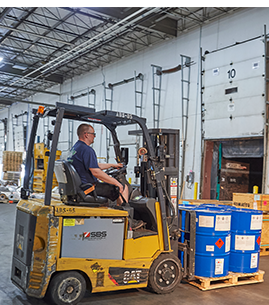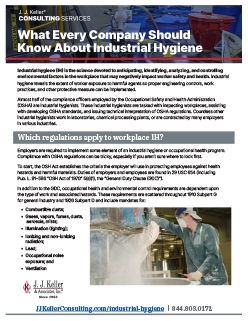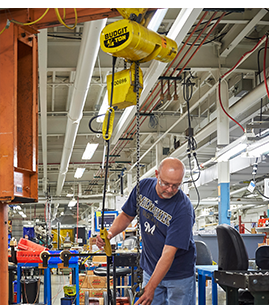We offer both area and personal noise monitoring. We determine if hearing protection should be required, even for short durations of exposure, as well as determining who needs to be included in a hearing conservation program. We can also develop your hearing conservation program and complete the PPE hazard assessments required by OSHA.
Hearing Conservation, Air Monitoring, Ergonomics, Laser Safety
Our industrial hygiene programs provide a complete solution for minimizing workplace hazards that can result in injury, illness or affect the well-being of workers. Service components may include a hazard assessment, ongoing monitoring, policy & procedure review and development, and supervisor and employee training.
How We Can Help
Assessment
We will provide assessments of hazards for ergonomics and laser safety management, along with a report and recommendations. We can also provide exposure assessments for:
- Airbourne dust and contaminents
- Asbestos, mold, lead, hazardous gases and vapors
- Noise
Monitoring
We can provide one-time and ongoing monitoring of noise and air quality hazards and exposure levels in your work environment to develop a baseline for future monitoring and provide recommendations to mitigate risks.
Policy & Procedures Development and Review
We will work with you to develop a company or operation-specific policy with specific procedures and controls, including applicable personal protective equipment.
Training Program
We can provide initial and annual training for supervisors and employees.
Our Most Popular Industrial Hygiene Services:
- Hearing Conservation
- Air Monitoring
- Ergonomics
- Laser Safety
Hearing Conservation
Air Monitoring
Your J. J. Keller safety consultant will work with you to determine what constituents need to be evaluated in your workplace, including chemical and byproduct exposures to volatile organic compounds, dusts, vapors, mists, fumes and other air contaminates, including mold. You’ll receive an exposure report and recommendations to ensure you’re protecting your employees and complying with all federal and state standards and emphasis programs. J. J. Keller will also develop or review your policies and procedures and help you track and manage your air monitoring, training, and medical surveillance records.
Ergonomics
You can prevent musculoskeletal disorders, one of the leading workplace injuries in all industries, by creating an ergonomically sound workspace. Our experienced consultants will spend time with your workers, job shadowing and conducting interviews to identify problem areas and offer recommendations for engineering, administrative or PPE controls.
Laser Safety
Eye safety is the number one concern when working with or near a laser. Our consultants will evaluate your laser exposures, match PPE and signage to the various lasers in your facilities, and develop or review your company’s policies for laser safety. We can also assist you with laser safety training, if needed.
Certified Industrial Hygienists (CIH) at J. J. Keller
As a client, you’ll work with one of J. J. Keller's certified industrial hygienists!
Carl Sall and Stacey Croghan bring more than 20 years of experience to the team, combining regulatory knowledge with extensive industry experience to provide guidance for achieving and maintaining compliance.
Frequently Asked Questions
Industrial hygiene (IH) is the science devoted to anticipating, identifying, analyzing, and controlling environmental factors in the workplace that may negatively impact worker safety and health. Industrial hygiene reveals the extent of worker exposure to harmful agents so proper engineering controls, work practices, and other protective measures can be implemented.
- Anticipation – assessing what hazards may be present.
- Recognition – identifying hazards that are present.
- Evaluation – determining levels of exposure through monitoring, surveillance, and data analysis.
- Control – recommending methods for controlling or preventing risk through engineering, work practices, and personal protective equipment.
A certified industrial hygienist (CIH) is a professional devoted to protecting the health and safety of workers and the community by identifying and evaluating chemical, physical, biological, or ergonomic hazards and recommending corrective action plans to eliminate or minimize those hazards. A CIH may also help businesses with risk assessments and job hazard analysis, developing health and safety programs, planning for emergency response, conducting feasibility studies, monitoring noise and other exposures, and ensuring regulatory compliance.
CIHs have extensive education in fields like biology, chemistry, physics, or engineering from an accredited college or university. Their academic background, real-world experience, and regulatory know-how make them experts in areas like occupational health and safety, industrial hygiene, science-based technologies, mathematics, ergonomics and health stressors, and ethics.
- Air contaminants - Particulate or gas and vapor contaminants including dusts, fumes, mists, aerosols, and fibers.
- Biological hazards - Bacteria, viruses, mold, and other living organisms that can cause infections.
- Chemical hazards - Hazardous solids, liquids, gases, mists, fumes, dusts, and vapors.
- Ergonomic hazards – Tasks that expose workers to eye strain, repetitive motion, heavy lifting, awkward or static body postures, excessive vibration and noise.
- Physical hazards - Ionizing and non-ionizing electromagnetic radiation, noise, vibration, illumination (lighting), and temperature extremes.
One of the most common workplace injuries are due to muscoloskeletal disorders (MSDs), which are typically caused by the repetitive motion found in manufacturing, construction, service and office industries. Although ergonomics is not specifically called out by OSHA, the General Duty Clause requires employers to take action to correct or eliminate all injuries in the workplace.
- Inhalation: Breathing in hazardous chemicals or particles.
- Absorption: Direct skin contact with harmful substances.
- Ingestion: Swallowing or consuming hazardous materials.
- Injection: Exposure through skin punctures, cuts or abrasions by sharp objects.
The OSH Act sets the standards for employers to protect employees from health hazards and harmful materials. The General Duty Clause (GDC) requires employers to provide a safe workplace free from recognized hazards. You can find more information about the duties of employers and employees in 29 USC 654, which includes the General Duty Clause (GDC) under Pub. L. 91–596 "OSH Act of 1970" 5(a)(1).
In addition to the GDC, occupational health and environmental control requirements are dependent upon the type of work and associated hazards. These requirements are scattered throughout 1910 Subpart G for general industry and 1926 Subpart D and include mandates for:
- Combustible dusts;
- Gases, vapors, fumes, dusts, aerosols, mists;
- Illumination (lighting);
- Ionizing and non-ionizing radiation;
- Lead, asbestos, cadmium, and formaldehyde;
- Bloodborne pathogens;
- Occupational noise exposure; and
- Ventilation
Yes, OSHA’s Appendix B to 1910.1029 provides guidelines for industrial hygiene and medical surveillance that includes sampling, analysis, and pulmonary fit test guidance.
The primary risk exposure from lasers is damage to a person’s retina or vision. All lasers are classified in one of four potential classes. Class 1 lasers are the only class of lasers that don’t present any risk exposure. Class 2 and above present risks that require safety protection. Many companies are not aware that simply giving employees PPE is not enough.
Resources
Occupational Noise Hazards in the Workplace, Part I
One of the most prevalent work-related hazards in all industries is occupational noise. However...
FREE Compliance Brief
Learn which regulations apply to workplace IH, what IH services are, the benefits of third-party IH services, and more!
Reducing Workplace Injuries Through Ergonomics
Ergonomic injuries are covered under the General Duty Clause of the OSH Act, which requires employers to provide...
I'd like to learn more!
Talk with a compliance specialist today at 844-803-0172 or fill out the form and we'll get in contact with you.
Thank You!
Thank you for your interest! A Compliance Specialist will contact you soon regarding your request.
We're sorry, there was an issue in submitting the form.
Please refresh the page and resubmit your information.




